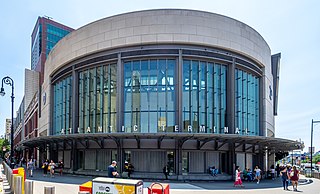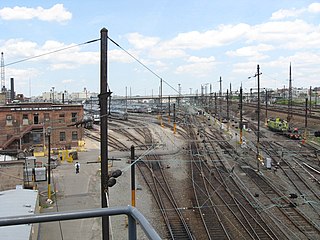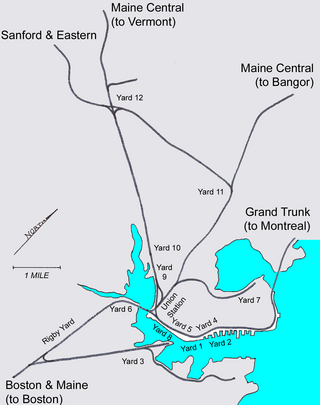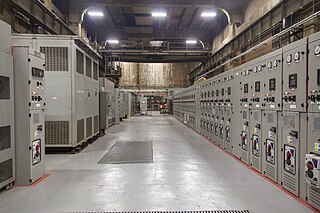
Grand Central Terminal is a commuter rail terminal located at 42nd Street and Park Avenue in Midtown Manhattan, New York City. Grand Central is the southern terminus of the Metro-North Railroad's Harlem, Hudson and New Haven Lines, serving the northern parts of the New York metropolitan area. It also contains a connection to the New York City Subway at Grand Central–42nd Street station. The terminal is the second-busiest train station in North America, after New York Penn Station.

The Waldorf Astoria New York is a luxury hotel in Midtown Manhattan in New York City. The structure, at 301 Park Avenue between 49th and 50th Streets, is a 47-story 625 ft (191 m) Art Deco landmark designed by architects Schultze and Weaver, which was completed in 1931. The building was the world's tallest hotel from 1931 until 1963 when it was surpassed by Moscow's Hotel Ukraina by 23 feet (7.0 m). An icon of glamour and luxury, the current Waldorf Astoria is one of the world's most prestigious and best-known hotels. Waldorf Astoria Hotels & Resorts is a division of Hilton Hotels, and a portfolio of high-end properties around the world now operates under the name, including in New York City. Both the exterior and the interior of the Waldorf Astoria are designated by the New York City Landmarks Preservation Commission as official landmarks.

Cortlandt station is a commuter rail stop on the Metro-North Railroad's Hudson Line, located in Montrose, New York. Trains leave for New York City every hour on weekdays, and about every 25 minutes during rush hour. It is 38.4 miles (61.8 km) from Grand Central Terminal and travel time to Grand Central is about 62 minutes.

Glenwood station is a commuter rail stop on the Metro-North Railroad's Hudson Line, located in the Glenwood neighborhood of Yonkers, New York. Trains leave for New York City every hour on weekdays, and about every 25 minutes during rush hour. It is 15.5 miles (24.9 km) from Grand Central Terminal and travel time to Grand Central is about 38 minutes.

Wassaic station is a commuter rail stop on the Metro-North Railroad's Harlem Line, located in Amenia, New York. It is the northern terminal of the Harlem Line. Trains leave for New York City every two hours, and about every 30 minutes during rush hour. It is 28.8 miles (46.3 km) from Southeast station and 82 miles (132 km) from Grand Central Terminal and travel time to there is approximately two hours, twelve minutes.

The IRT Ninth Avenue Line, often called the Ninth Avenue Elevated or Ninth Avenue El, was the first elevated railway in New York City. It opened on July 3, 1868 as the West Side and Yonkers Patent Railway, as an experimental single-track cable-powered elevated railway from Battery Place, at the south end of Manhattan Island, northward up Greenwich Street to Cortlandt Street. It ceased operation on June 11, 1940, after it was replaced by the IND Eighth Avenue Line which had opened in 1932.
The BMT Astoria Line is a rapid transit line of the B Division of the New York City Subway, serving the Queens neighborhood of Astoria. It runs south from Ditmars Boulevard in Astoria to 39th Avenue in Long Island City above 31st Street. It then turns west and serves Queensboro Plaza over Queens Plaza.

Atlantic Terminal is the westernmost stop on the Long Island Rail Road's (LIRR) Atlantic Branch, located at Flatbush Avenue and Atlantic Avenue in Downtown Brooklyn, New York City. It is the primary terminal for the Far Rockaway, Hempstead, and West Hempstead Branches. The terminal is located in the City Terminal Zone, the LIRR's Zone 1, and thus part of the CityTicket program.
East Side Access (ESA) is a public works project in New York City that will extend the Long Island Rail Road (LIRR) from its Main Line in Queens into a new station under Grand Central Terminal on Manhattan's East Side. A project of the Metropolitan Transportation Authority (MTA) originally scheduled to open in 2009, the new station and tunnels are tentatively scheduled to start service in December 2022. The project's estimated construction cost rose nearly threefold from the planned $3.5 billion to $11.1 billion as of April 2018, making it one of the world's most expensive underground rail-construction projects.

Sunnyside Yard is a large coach yard, a railroad yard for passenger cars, in Sunnyside, Queens in New York City.

Port Washington is the terminus of the Long Island Rail Road's Port Washington Branch in Port Washington, New York. The station is located on Main Street, between Haven Avenue and South Bayles Avenue, just west of Port Washington Boulevard, and is 19.9 miles (32 km) from Pennsylvania Station in Midtown Manhattan. A pedestrian bridge exists between the platforms, and is in line with Franklin Avenue, ending at Haven Avenue.

Tuckahoe station is a commuter rail stop on the Metro-North Railroad's Harlem Line, located in the village of Tuckahoe, New York. It is 16 miles (25.7 km) from Grand Central Terminal and travel time there is approximately 39 minutes. As of August 2006, daily commuter ridership was 1,378 and there are 314 parking spots. The station is located in the Zone 3 Metro-North fare zone.

The Portland Terminal Company was a terminal railroad notable for its control of switching (shunting) activity for the Maine Central Railroad (MEC) and Boston & Maine (B&M) railroads in the Maine cities of Portland, South Portland, and Westbrook.

The Highbridge Facility, also simply known as Highbridge or High Bridge, is a maintenance facility for the Metro-North Railroad in the Highbridge section of the Bronx, New York City, United States. It is the third stop along the Hudson Line north of Grand Central Terminal, and is for Metro-North employees only, though this stop also formerly served commuter rail passengers and was called High Bridge station. The station is located south of the High Bridge off Depot Place and Exterior Drive, and is accessible from Sedgwick Avenue by way of a viaduct that carries Depot Place over the Major Deegan Expressway, the Hudson Line, and Exterior Drive.

The West Side Yard is a rail yard of 30 tracks owned by the Metropolitan Transportation Authority on the west side of Manhattan in New York City. Used to store commuter rail trains operated by the subsidiary Long Island Rail Road, the 26.17-acre (10.59 ha) yard sits between West 30th Street, West 33rd Street, 10th Avenue and 12th Avenue.

Harold Interlocking is a large railroad junction located in New York City. It is the busiest rail junction in the United States. It serves trains on Amtrak's Northeast Corridor and the Long Island Rail Road's Main Line and Port Washington Branch, which diverge at the junction.

Grand Central Terminal is a major commuter rail terminal in Midtown Manhattan, New York City, serving the Metro-North Railroad's Harlem, Hudson and New Haven Lines. It is the most recent of three functionally similar buildings on the same site. The current structure was built by and named for the New York Central & Hudson River Railroad, though it also served the New York, New Haven and Hartford Railroad. Passenger service has continued under the successors of the New York Central and New Haven railroads.

M42 is a sub-basement of Grand Central Terminal in Midtown Manhattan, New York City. The basement contains an electrical substation that provides electricity to the terminal and helps power its tracks' third rails.

Terminal City, also known as the Grand Central Zone, is an early 20th century commercial and office development in Midtown Manhattan, New York City. The space was developed atop the former Grand Central Station railyard, after the New York Central Railroad decided to rebuild the station into Grand Central Terminal, and reshape the railyard into a below-ground train shed, allowing roads and skyscrapers to be built atop it.


















